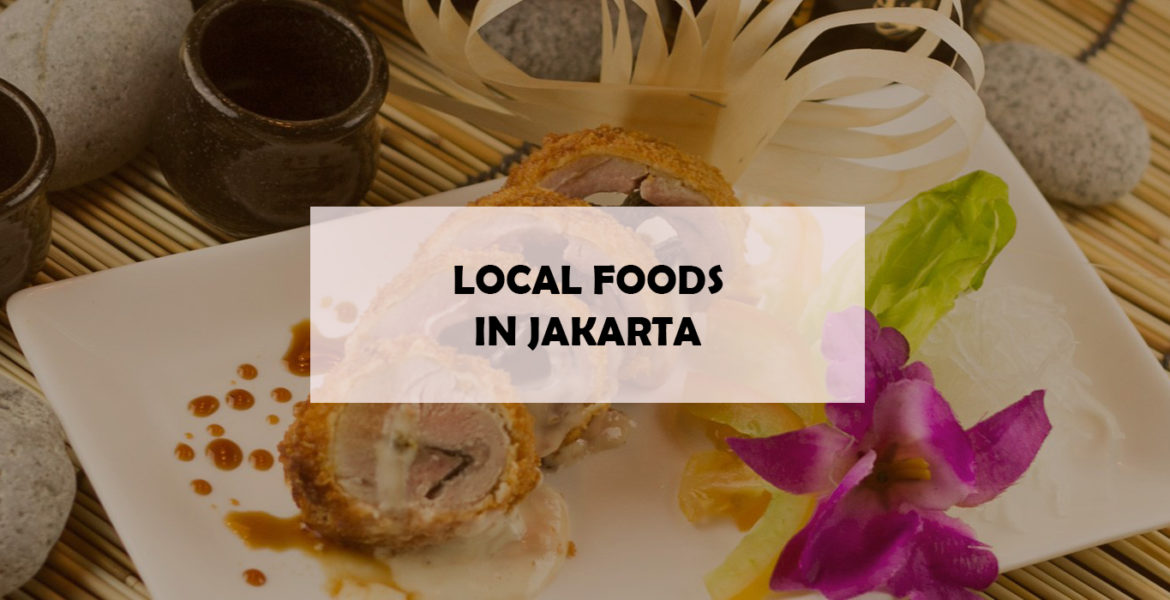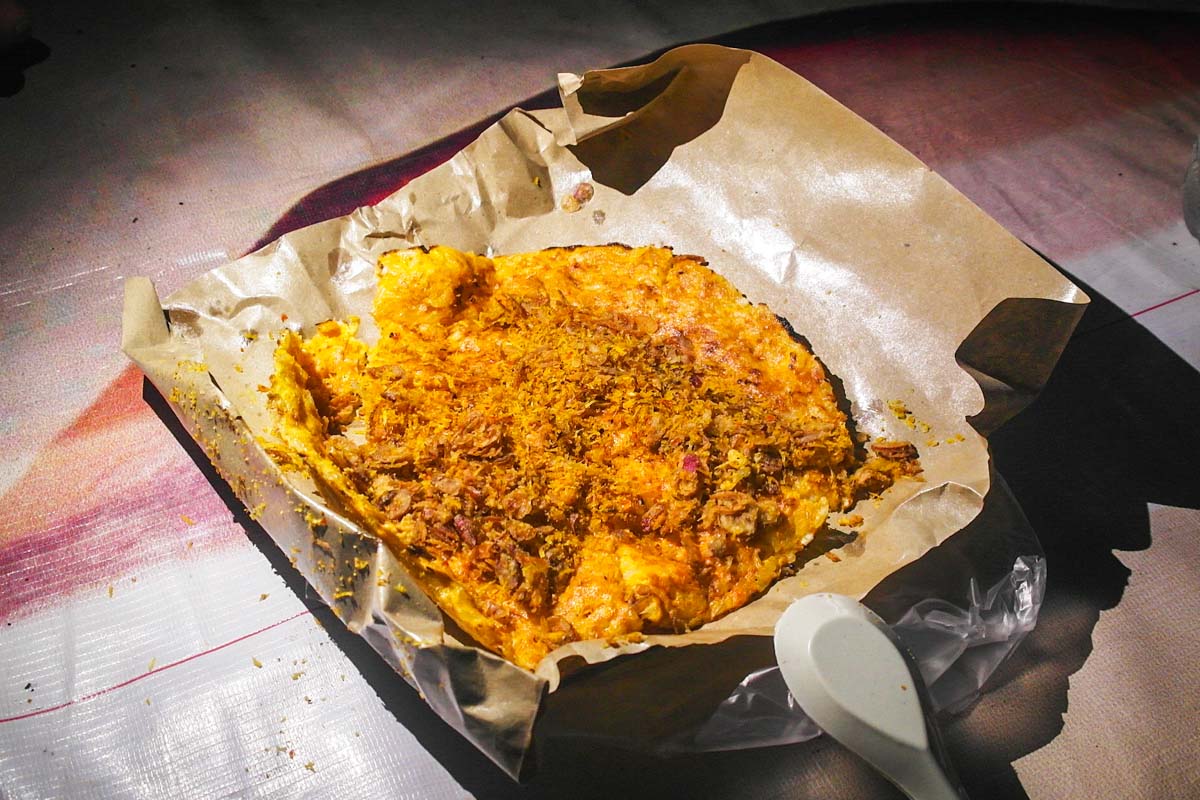21 Must Eat Local Foods When You Visit Jakarta, Indonesia
Indonesia is a huge country, and even the city of Jakarta itself is larger than Singapore. With an endless growth of new Western influenced restaurants, it can be easy to forget about the street hawker food that most Indonesian locals actually frequent. This guide serves to provide an authentic guide on what foods to eat in Jakarta which you can find at the road side, small shops and even in restaurants or food courts.
Indonesia cuisine, because of it’s strategic trading geography, also sees influences from China, India and European countries which become even more distinct near the coastal cities. Hainanese origin of many dishes is also prevalent from the influx of Chinese in the past.
Many of the foods in Jakarta city have been brought in from various parts of Indonesia and been adapted to the region. For the sake of simplicity, I will only be highlighting common foods that can be found here, even though there is an endless variation if you just venture out of Jakarta.
1. Pisang Goreng Sambal Roa (Fried Banana with Chili)

Pisang Goreng is a deep fried batter fritter and in Indonesia, is accompanied with Sambal chili. The banana used in Jakarta is not overly ripe and sweet unlike Singapore, still retaining a starchy firm body. The sambal roa is made with fish and adds extreme spicy kick. Comes with fritters as well for added crunch and is a popular snack for many locals.
Recommended Stall:
Mr Banana Pisang Goreng Pontianak Uya Kuya: Jembatan ITC Mall Ambassador No. 8, Jl. Prof. Dr. Satrio, Kuningan
2. Gorengan (Fried Foods)
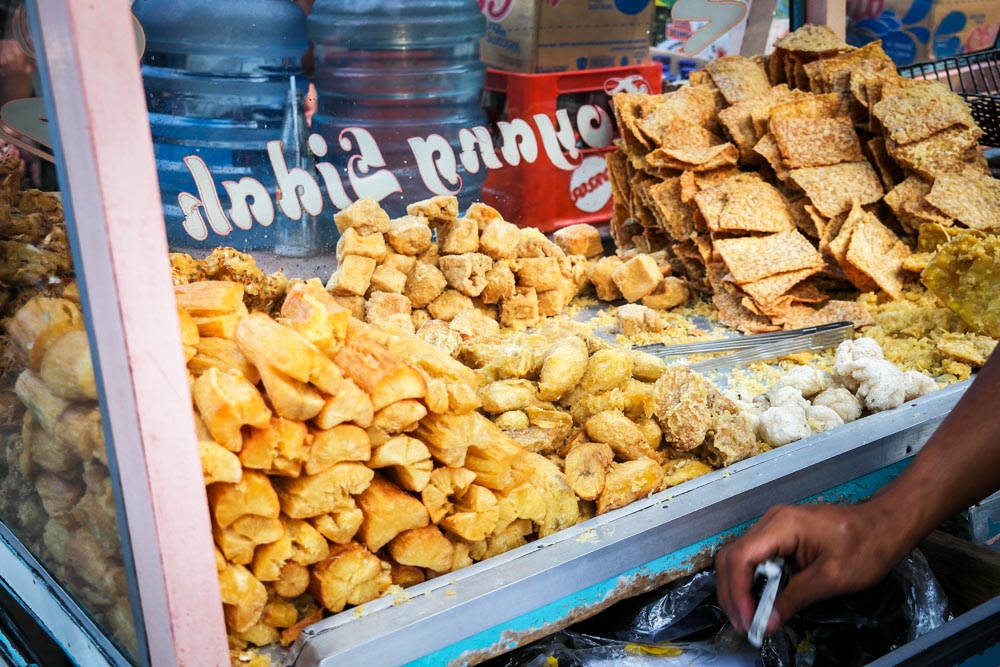
Gorengan literally means ‘fried things’, which is what this popular push cart (geropak) sells. All sorts of ingredients are deep fried and sold, including yam, pineapple, Tempeh (fermented soy beans), tofu, spring rolls and many others. No doubt unhealthy and a precursor for a heart attack as the oil is re-fried an unknown number of times. Reused oil always seems to taste better.
The gorengan vendors by the road are life-savers, providing quick snacks for local motorists who are more often then not stuck in the infamous Jakarta traffic jams that can last hours. These ubiquitious carts are spread across many roads in Jakarta and it’s hard to miss.
Recommended Stall:
Aneka Gorengan: Pasaraya Grande, Lantai Lower Ground, Dapuraya, Jl. Iskandarsyah II, Melawai, Jakarta
3. Otak-Otak (Brain-Brain Fish Cake)
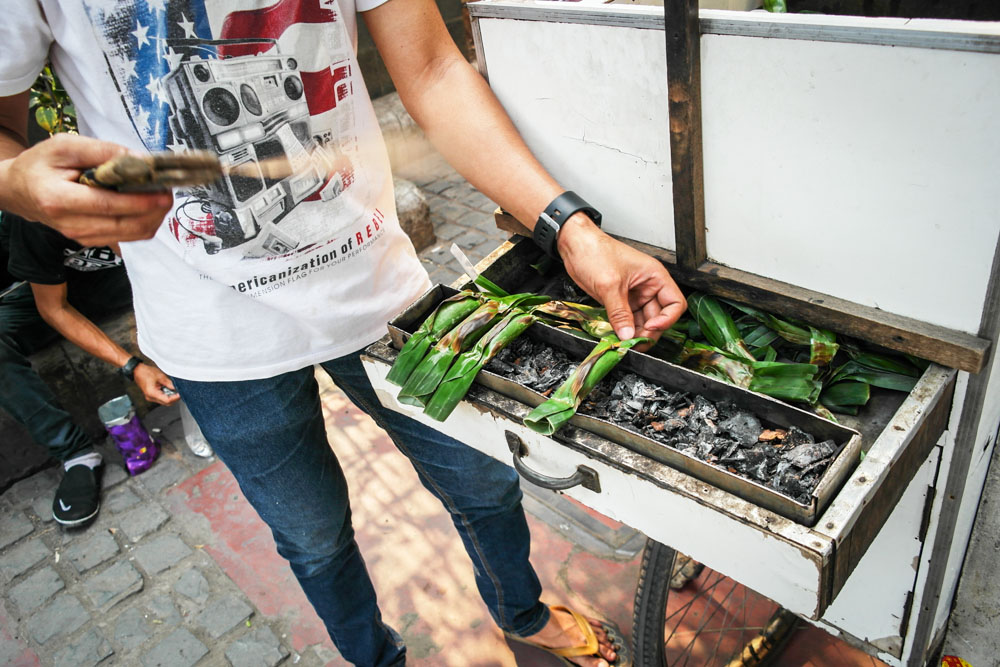

Otak-Otak is popular in Indonesia, Malaysia and Singapore but of course with their variations. I find the Indonesian version to differ the most from the other regions, being mostly pale whitish in color with only little or no chili within the fish paste mix itself. The Jakarta otak fish paste is mostly made with ikan tenggiri (wahoo fish), coconut milk, lemongrass and spices, and is grilled or steamed in banana leaf like other variations of otak for added fragrance.
Otak literally means ‘brain’, which could be derived from the idea that this dish looks like a soft, squishy fish brain.
The Jakarta version however also sees the use of spicy peanut sauce that the otak-otak is dipped in. You can also find otak-otak stalls setup along the street or near bus stops that cater to passerbys.
Recommended Stall:
Otak-Otak Sangaji: Jl A.M. Sangaji, Petojo, Jakarta, Indonesia
4. Bakpao (Meat Bun)
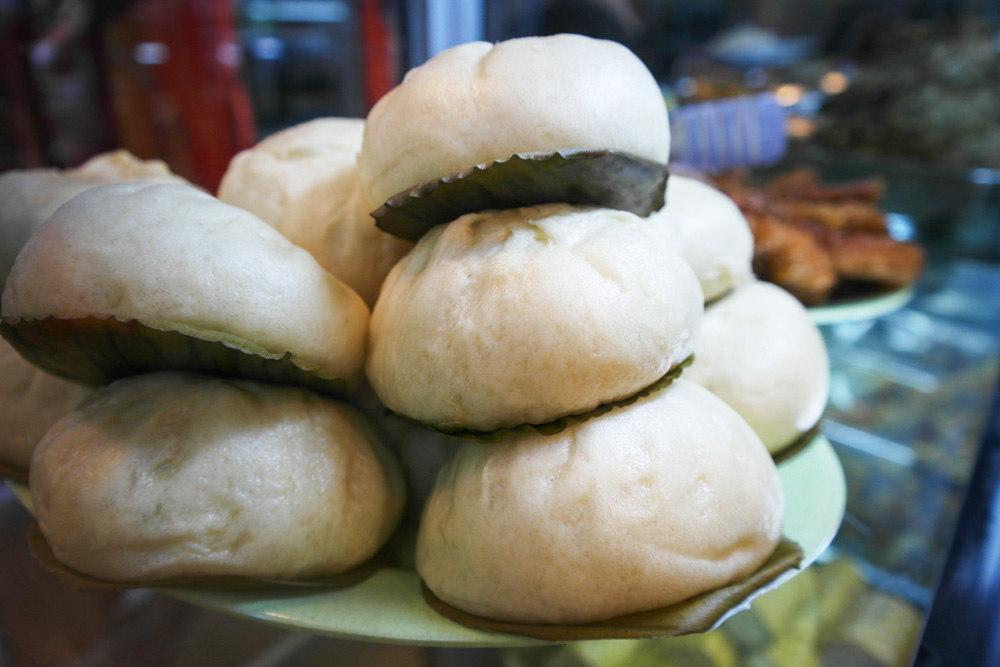
Bakpao is adopted from the Hokkien name 肉包, which literally means meat dumpling or bun. Originally of Chinese origin from the many Hokkiens living in Indonesia, Bakpao’s initial recipe used pork meat, while many Indonesians have adapted the Bakpao to be filled with other Muslim friendly ingredients like Chicken or vegetables.
The skin is made with dough and after being stuffed, is left to expand from being steamed.
Recommended Stall:
Bakpao Lombobattang: Jl. Boulevard Raya PD9 No. 11, Kelapa Gading, Jakarta, Indonesia
5. Ketoprak Jakarta

Photo: oracleandtarotgoddess.wordpress.com
Ketoprak is another typical street food in Jakarta but has also spread across Java with its popularity. The vegetarian Ketoprak consists of tofu, lontong (compressed rice cake), beehoon, boiled egg, bean sprouts and cabbage, doused in peanut sauce and topped with fried shallots and kerupuk (deep-fried flavoured rice crackers).
You may also request for the level of spiciness you desire in each individual Ketoprak in most places, with a choice of mild, medium or burn your tongue off.
Recommended Stall:
Ketoprak Ciragil: JL. Cikatomas, II/24, Kebayoran Baru, Jakarta Selatan, DKI Jakarta 12180, Indonesia
6. Kerak Telor (Spicy Omelette)
Kerak Telor is made from glutinious rice fried with duck egg, and topped with shredded coconut, fried shallots and dried shrimp. Duck egg is considered to be more flavorful over chicken eggs, which I have to agree.
A Betawi traditional snack, Kerak Telor vendors are most prominent during the annual Jakarta fair and considered a popular choice for visitors. In the past, Kerak Telor was also considered to be food for the wealthy and served during parties.
Recommended Stall:
There are a couple street vendors around Fatahillah Square: Old Batavia, Jakarta, Indonesia
7. Bebek Goreng (Fried Duck)

Photo: http://triobebek.com/
Bebek Goreng can be found in many street stalls as well as fancier restaurants and is usually sold with rice. Because of this, Bebek Goreng is sometimes also sold as ‘Nasi bebek’ or duck rice. This dish is traditionally eaten with the hands only to really reach every nook and cranny of the duck. There is also a fried chicken version known as Ayam goreng.
The duck is usually marinated with a variety of spices like galangal ginger, lemongrass, bay leaves and cumin, then fried in a pan with loads of oil till its crispy brown.
Bebek Goreng Pak Joko Putra (food cart): Jl. Petogogan, DKI Jakarta, Indonesia
Bebek Bengil: The Ubud Building, Jalan H. Agus Salim No.132, Jakarta Pusat, DKI Jakarta 10310, Indonesia
8. Martabak Manis (Sweet stuffed pancake)

http://audreyscookinglab.blogspot.sg/
Martabak is a soft stuffed pancake and the filling vastly varies from country to country. In Indonesia, Martabak Manis is a popular street dessert version that sees all sorts of sweet ingredients within like condensed milk, cheese and even nutella and toblerone chocolate. The savoury, egg version also found in Indonesia is more commonly known as Martabak Malabar for locals to distinguish from the dessert variant.
The Martabak in Singapore is not stuffed and completely different from the Indonesian variety- The Ban Jian Kueh in Singapore seems to more closely resemble Jakarta’s Martabak Manis instead.
Recommended stall:
Martabak Boss: Jl. Yusuf Adiwinata No. 33,Menteng, Jakarta, Indonesia
9. Durian Pancake


Probably originating from Medan where there is an abundance of durian merchants, Durian pancakes have spread across Indonesia. Simply made with flour and durian cream puree, the most common presentation is the squarish stuffed pancake although a thinner crepe-like version is also popular.
Recommended Stall:
Ulliko Duren: Grand Indonesia Mall, Lantai Lower Ground, West Mall, Food Hall, Jl. MH Thamrin, Thamrin, Jakarta
10. Roti Bakar (Grilled Bread)

Photo: jakartacitylife.com
Roti Bakar is a thick toast that many Indonesians eat for breakfast or dessert. Street vendors selling Roti Bakar or ‘Ropita’ stalls often offer a variety of toppings including strawberry, banana cheese, pineapple and chocolates. Chocolate and cheese Roti Bakar appears to be the most popular choice among locals though, with a blend of melting shredded cheese and chocolate further sweetened with condensed milk drizzled all over the toast.
Taking the already sugary Roti Bakar to the next level, some stalls have the option to turn it into an ‘Es Roti Bakar’ by adding scoops of ice cream on top of your diabetic treat. Stand by the insulin shot when you try this.
Recommended Stall:
Roti Bakar Eddy: Jl. Raden Patah, Blok M, Jakarta
11. Sate (Satay)

This famous meat skewer originated from Java, Indonesia and has pretty much become the national dish- it’s no surprise this is my favorite item on the list and Indonesia is where I’ve eaten the best satay in my life.
A popular delicacy consisting of meats like chicken, beef and mutton, each satay is grilled over wood or charcoal fire for that familiar barbecue flavour. The most popular version is also accompanied with spicy peanut and pineapple sauce. Variations include satay made with offal or intestines with a plethora of different sauces.
From street hawkers to high class restaurants, you can find satay pretty much anywhere in Indonesia.
Recommended Stall:
Sate Khas Senayan: Jl. Kebon Sirih No. 31A, Jakarta Pusat, DKI Jakarta 10250, Indonesia
12. Sop Buntut (Oxtail Soup)
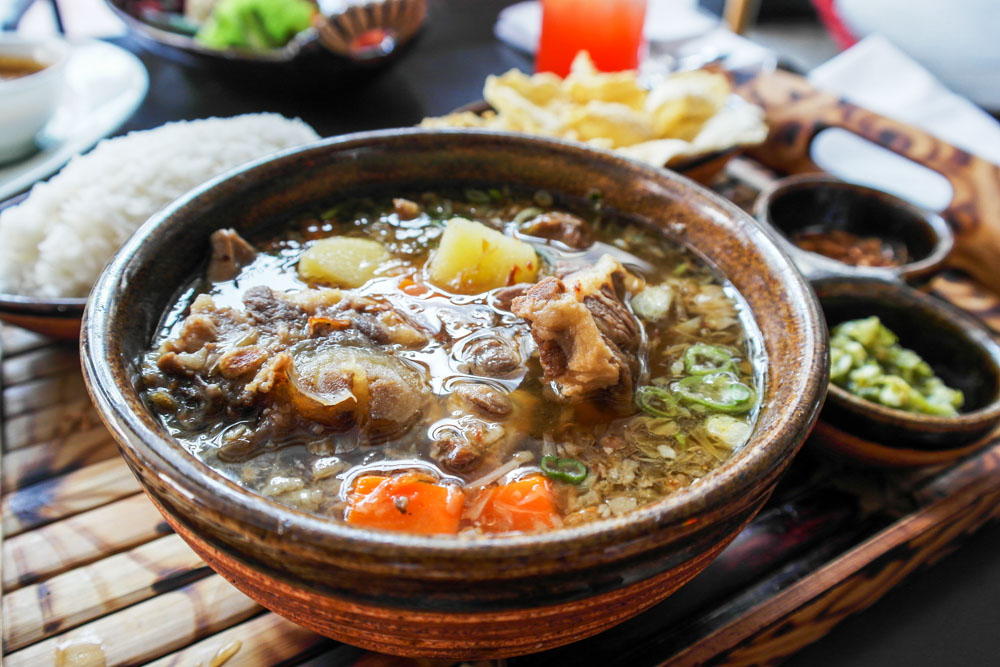
Sop Buntut is another well-known food in Indonesia. The ‘ox’ in oxtail soup actually just refers to beef and not any specific cow, and probably incorporated because it’s unwanted by butchers (nowadays oxtail is quite in demand). In Indonesia, slices of fried or barbecued oxtail is cooked in a clear, rich beef broth with loads of vegetables.
A new variant called ‘Sop Buntut Goreng’ has also surfaced, with the oxtail being seasoned and fried dry separately from the soup.
Recommended stall:
Sop Buntut Bogor Cafe: Jl Jend Sudirman Kav 52-53, Pacific Place Mall Level 5-57, SCBD, Jakarta, Indonesia
13. Soto Mie (Indonesian Soup Noodles)

Photo: www.mobypicture.com
Soto Mie is a spicy noodle dish which itself is actually noodles added to ‘Soto’, traditional Indonesian soup. Due to the gazillion variations of ‘Soto’ depending on the origin of soup, there are also countless variations of Soto Mie based on the soup. Two of the most popular Sotos in Jakarta are the Soto Mie Bogor (beef tendon/cartilage) and Soto Mie Betawi (beef offal with milk).
Recommended stall:
Mie Kocok Bandung Soto Mie Urat: Jl. Pegangsaan, Kelapa Gading, Apartment Gading Nias Residence NL-20, Jakarta 14250, Indonesia
14. Kopi Luwak (Civet Coffee)

Indonesia is the fourth largest coffee producer in the world, and it’s no surprise they have some amazing coffee. But one of the weirdest coffee recipe discoveries would have to be Kopi Luwak, or Civet Coffee. Seeds of coffee berries that have been ingested and defecated by the Civet cat is collected and then processed into coffee. Its interesting to wonder what was going through the mind of the first Kopi Luwak discoverer who thought it would be a good idea to brew coffee from Civet cat feces.
Authentic Kopi Luwak is one of the most expensive coffees in the world, with prices reaching US$700 per kilogram due to the tedious process of harvesting. The way the Civet selects good coffee berries for consumption, and the digestion of the coffee berries are said to enhance the flavour of coffee.
Recommended Stall:
Kopi Luwak: Kuningan City, Lantai Upper Ground, Jl. Prof Dr Satrio, Kuningan, Jakarta
15. Bakso (Meatball)

Bakso is an Indonesian meatball usually made from ground beef paste and tapioca flour. However, bakso can also be made from shrimp, fish or chicken. Bakso is typically served with a beef broth with vermicelli or yellow noodles.
The name Bakso is derived from the Hokkien pronunciation for shredded meat, which is ‘bah-so’, suggesting a Indonesian Chinese origin. Bakso has a firmer and denser texture as compared to other meatballs around the world.
Recommended Stall:
Bakso Mas Kumis: Kompleks PT Djarum (Jalan Aipda Karel Satsuit Tubun 2), Jakarta Pusat, DKI Jakarta, Indonesia
16. Es Campur (Mixed Ice Dessert)

Photo: www.tempatonlineku.net
Es Campur is a frozen dessert that means ‘mixed ice’. Blocks of ice are shaved finely with a machine onto an assortment of treats like grass jelly, jack fruit, avocado and coconut in a bowl. The ice is then drizzled with colored sugar syrup and condensed milk for a vibrant presentation.
As with many of the desserts in Indonesia, Es Campur is on the sweeter side as well. Some versions even have a scoop of durian flesh topped above the ice.
Recommended Stall:
Remboelan: Jl. Asia Afrika No. 8, Plaza Senayan, 4th Floor, Unit 408 A, Jakarta, Indonesia
17. Gado-Gado (Mix Salad)

Photo: dmagzphotogallery.blogspot.com
Gado-Gado is an Indonesian salad with a rich mix of boiled vegetables such as potato, string beans, corn, bitter gourd, cabbage, spinach along with tofu, tempeh and hard-boiled egg all mixed in peanut sauce. Kerupuk crackers are also sometimes added in. The peanut sauce for Gado-Gado is slightly different from the satay peanut sauce, whereby Gado-Gado sauce has Terasi (dried prawn paste) as one of its common ingredients.
Recommended Stall:
Gado-Gado Bonbin: Jalan Wahid Hasyim No. 87, Jakarta Pusat, Jakarta, Indonesia
18. Nasi Padang (Padang-style Rice)

Photo: jakartasavvy.com
Nasi Padang is basically an array of pre-cooked dishes served with steamed rice, originating from Padang City. The steamed rice is usually also accompanied with gulai Cubadak (jackfruit). Typical dishes served in a padang are Indonesian styled items like Ayam Bakar (grilled chicken), Gulai Ati (cow liver), Udang Balado (chili shrimp) and many more.
There are 2 serving styles in a Padang restaurant- the ‘pesan’ (order) method involved the customer examining the dishes on display and just picking out what he wants; the ‘hidang’ (serve) method will have dishes brought out to the table immediately after guests have been seated in a buffet-style manner for larger banquets.
Recommended Stall:
Rumah Makan Garuda: Jalan H. Agus Salim/ Sabang No. 59 Jakarta Pusat, Indonesia
19. Sop Kambing (Mutton Soup)
Sop Kambing is a classic broth made of mutton brewed for hours and flavoured with spices such as coriander, fennel, cumin, star anise and cinnamon. Kambing means ‘Goat’ in Indonesian, which can be called mutton as well.
Although mutton is primarily used for this soup, sometimes chicken and beef are added to enrich the broth. The meat is braised in curry powder before it is cooked. The greenish-yellow hue of the broth comes from the spices used while the meat adds a unique sweetness although the gaminess of the mutton is quite prominent. Some joints also add in bone marrow for extra umami flavours. The soup is served hot and topped with coriander leaves and deep fried sliced shallots, accompanied by rice on the side.
Recommended Stall:
Sop Kaki Kambing Bang Hasan: Jl. Boulevard Raya Blok QJ 7 No. 2, Kelapa Gading, Jakarta, Indonesia
20. Siomay (Steamed Fish Dumpling)
Siomay is a Chinese Indonesian steamed fish dumpling, much like the Chinese Shu Mai 烧卖 which uses mainly pork instead. The Indonesian version also uses other types of seafood like tuna, mackerel and prawn. The Siomay is served whole or cut into bite-sized pieces then topped with peanut sauce, sweet soy sauce and chili.
Recommended Stall:
Ika Siomay: ITC Kuningan, Lantai Lower Ground Blok TRW, Jl. Prof Dr Satrio, Kuningan, Jakarta
21. Bubur Ayam (Chicken Congee)
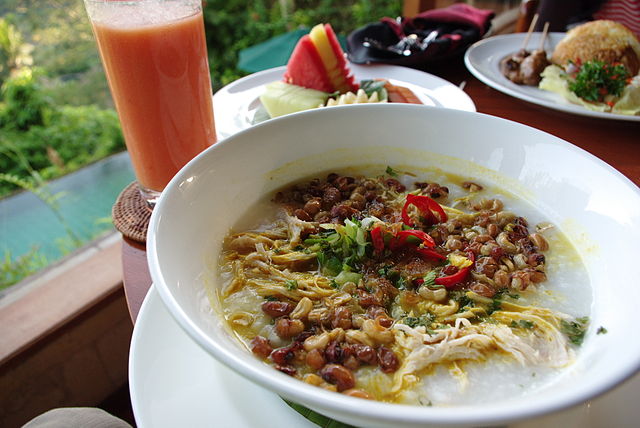
Bubur Ayam is the Indonesia version of chicken congee, which is very common in Asia. This simple rice congee is served with shredded chicken with condiments such as chopped celery, fried scallion and shallots as well as Tongcay (preserved salted vegetables). Sometimes there’s also cakwe (youtiao 油条) add which further hints of this dish’s Chinese roots.
A popular breakfast dish that can be found in many warungs (small local shops), many travelling push carts also dish it out at residential areas in the morning.
Recommended Stall:






